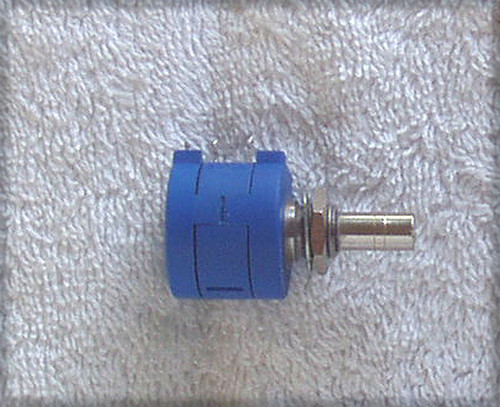BACKGROUND:
Ex TEPCO BOP 50-8M Bipolar Power Supply (fully functioning but it has now become an "organ donor")
BOURNS - Industrial Panel Potentiometer
Made in Mexico
Type: 82 series
Part # 82E1JE20A15
Full identification is stamped into the rear metal cover plate
82E1JE20A15
10k MEXICO
115-2612
9409X
It took a little work to decode the Bourns part number, not helped by the age of this pot, but the information below is extracted from their various datasheets
Value: 10K
20% tolerance
Linearity: +/- 5%
Taper: Linear
Single turn
Panel mounting (supplied with nut & washer)
Round 1/4" shaft (actually it measures 6.20mm which is just shy of 1/4") with a "slot" for the user to make adjustments
SPECIAL FEATURE: This pot has what Bourns refers to as an S bushing. This is similar in concept to a collet knob where a nut is wound onto the thread and it causes the shaft to "grab" onto the central shaft. This means that you make an adjustment using the front "slot" and then tighen the nut to make sure it does not move, and it will not move because this type of mechanical shaft locking is extremely secure.
DIMENSIONS:
Body: 17.09mm x 15.90mm x 14.6mm height
All metal "caps" at each end of the pot
Panel mounting hole required: minimum 6.25mm
Locking tab to secure position on the panel
Panel nut & lock washer
Shaft length: 14mm
S bush nut (much larger than the panel mounting nut)
Side mounted wire (0.75mm diameter) terminations, minimum of 9.6mm in length
COSMETIC CONDITION:
USED
Clean and undamaged physically
Wire leads "look" a bit 'how's ya father' due to the way they were used in the original equipment. Inside of being connected to a PCB or solder point behind the front panel, the wire was fashioned into a loop and connecting wires were shaped as "hooks". I have made an effort to straighten those wire leads while ensuring the integrity where the wire enters the pot body remains sound.
I have just two of these pots left BUT one only does not have the locking nut, so one has it's nuts and one has no locking nut (top nut).
TESTING:
Being a USED potentiometer,
Measured track resistance of each pot and the results are:
10.08K
10.21K
10.83K
9.55K
All pot track resistances fall within the 20% tolerance, in fact they are within 10%
NO issues observed with linearity and no dead spots detected - nice smooth variation across the track. These pots have very high rotational life cycles but actually are barely ever changed in any case - set and forget.
These pots have now been placed into sealed clear plastic packs awaiting a new owner












